
From Early Bloomers to Winter Wonders: Choosing the Perfect Camellia for Every Season
Published: 06/08/2024 | Updated: 06/08/2024
Camellias are a beloved and diverse genus of evergreen shrubs and trees, renowned for their exquisite blooms that grace gardens worldwide. These ornamental plants have captivated horticulturists and gardeners for centuries, with a rich history dating back to ancient China and Japan. The camellia's journey to global popularity began in the 17th century when European explorers encountered these mesmerizing flowers in East Asia. Instantly enamored by their beauty and elegance, they brought camellias back to Europe, sparking a horticultural craze that continues today.


One of their most remarkable aspects is their incredible variety, spanning a wide range of bloom times, colors, and forms. From the delicate early bloomers that herald the arrival of spring to the hardy winter wonders that defy the cold, these resilient plants offer a kaleidoscope of floral delights throughout the year.
With hundreds of cultivars, enthusiasts can curate their gardens to showcase a continuous parade of blossoms, each more breathtaking than the last. In this article, we will discuss choosing the perfect camellia. Whether you prefer the classic formal double blooms, the whimsical peony forms, or the simplicity of single-petaled varieties, there is a camellia to suit every taste and garden style.
Choosing the Right Camellia
Selecting the perfect camellia for your garden requires careful consideration of several factors. Climate plays a crucial role, as different camellia varieties thrive in various temperature ranges and weather conditions. For instance, some cultivars are better suited for warm, humid environments, while others can withstand cooler temperatures and even light frosts.
Soil conditions are another essential aspect to consider. Camellias generally prefer well-draining, acidic soils with a pH range of 5.5 to 6.5. If your soil is too alkaline, you may need to amend it with sulfur or other acidifying agents to create an optimal growing environment for these acid-loving plants.
The desired bloom time is also significant when choosing a camellia variety. As mentioned, camellias can bloom from early fall through late spring, with different cultivars peaking at other times. If you want to enjoy a continuous display of blooms throughout the season, consider planting a mix of early, mid, and late-blooming varieties.
Additionally, consider the mature size and growth habit of the camellia you choose. Some varieties are compact and well-suited for containers or smaller gardens, while others can grow into large shrubs or small trees, requiring more space to thrive.
Finally, consider the overall aesthetic you want to achieve in your garden. Camellias come in many flower forms, from single to double blooms and colors, from pure white to deep reds and variegated hues. Choose varieties that complement your existing landscape and personal preferences.
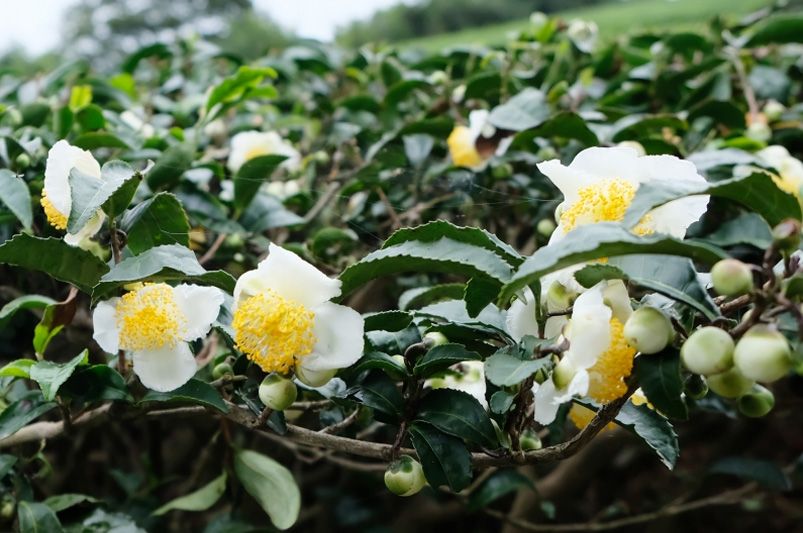
Camellia Brew-tea-ful
The Brew-tea-ful Camellia, the flowering shrub that gives us the sublime pleasure of tea, is a beautiful addition to your garden. Whether you're cultivating it for a delightful cup of morning green tea or a robust black tea, understanding the intricacies of its care is vital to a healthy harvest. Grown widely in USDA Hardiness Zones 7-9, this plant thrives under the right conditions.
Plantation & Growth
Camellia sinensis prefers a sheltered location with a light shade to protect it from scorching afternoons, yet it still requires several hours of morning sunlight. Acidic, well-drained soil rich in organic matter provides the perfect substrate. During plantation, ensure the hole is double the size of the root ball, providing ample space for roots to spread. Offering an ultimate growth height and spread of 4-6 feet, this plant can fit well into smaller gardens and even be cultivated in large containers.
Plant Care
Consistent watering is crucial, especially during dry spells, to keep the leaves lush and the buds robust. Mulching helps retain moisture and ward off weeds. A springtime fertilizer application formulated for acid-loving plants sets the stage for vibrant growth and development.
Pruning & Propagation
Annual pruning in late winter or early spring, after the last frost but before the first flush of growth, encourages a bushier plant and more abundant tea leaves. Propagation is typically done through cuttings or seed, with cuttings being more reliable for maintaining specific varietal traits.
Common Pests & Diseases
Camellia sinensis is relatively hearty, but watch for scale insects, spider mites, and aphids. Look for root rot and leaf gall, mainly if your plants are in poorly drained soil or an overly humid environment. Regular monitoring and prompt organic or chemical treatments can keep these potential issues at bay. With the proper care, your Brew-tea-ful plants will flourish, providing the raw, aromatic leaves that steep into the world's most beloved beverage.
Elevate your garden and wellness with the Brew-tea-ful Plant from ShrubHub! Cultivate your Camellia sinensis' Green Tea' and enjoy your backyard's fresh, antioxidant-rich brews. Perfect for health enthusiasts and garden lovers alike.
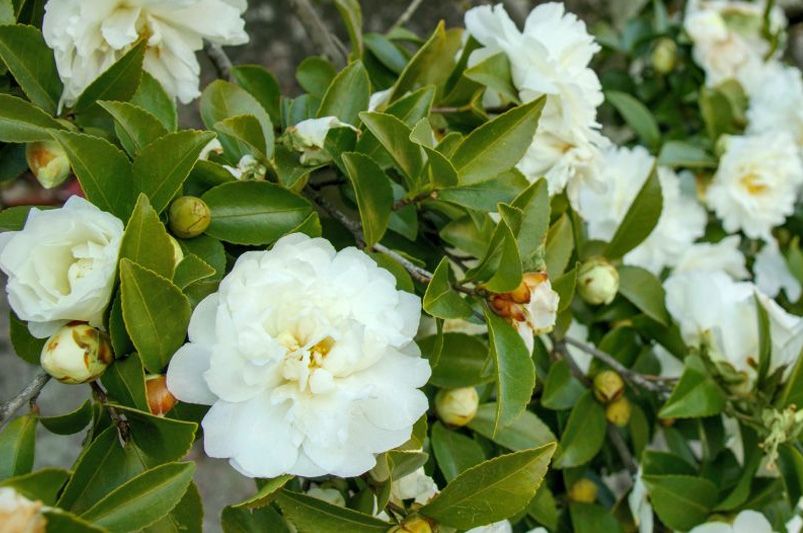
Dwarf White Camellia
The Camellia Dwarf White is a charming cultivar of Camellia japonica, renowned for its abundant blooms of pristine white flowers and glossy green foliage. Thriving in USDA Hardiness Zones 7 through 9, this compact shrub adds elegance and structure to more miniature landscapes, shaded garden areas, or container gardens.
Plantation & Growth
The ideal time for planting it is in the fall, which allows the plant's root system to establish during the cooler months. Choose a location that offers partial shade, as full sun can lead to leaf scorch, while deep shade may reduce flowering. The soil should be well-draining, acidic, and rich in organic matter. When planting, ensure that the top of the root ball is slightly above ground level to avoid waterlogging.
Plant Care
Regular watering is crucial, especially during the first few years after planting and during dry spells. A layer of mulch helps retain soil moisture and keeps roots cool. Feed with an acid-forming fertilizer in early spring and again in mid-summer to support vigorous growth and prolific blooming.
Pruning & Propagation
Pruning should be done in late winter or early spring before new growth starts but after the blooming period. This will maintain the shrub's compact shape and encourage more flowers. Propagation is most successful with a semi-hardwood cut, best done in late summer after flowering.
Common Pests & Diseases
While generally robust, Camellia Dwarf White is susceptible to scale, spider mites, and aphids. Preventative care includes regular cleaning of fallen debris and adequate spacing for air circulation. Camellia petal blight and root rot can also present problems in damp conditions, so ensuring proper soil drainage and avoiding overhead watering are essential preventive measures. With these care tips, your Camellia Dwarf White will be a stunning highlight in the garden through many seasons.
Brighten your garden with the graceful Camellia Dwarf White from ShrubHub! Perfect for small spaces, this low-maintenance, fragrant beauty adds a touch of elegance to any setting. Get your Camellia Dwarf White today and effortlessly elevate your garden's charm!
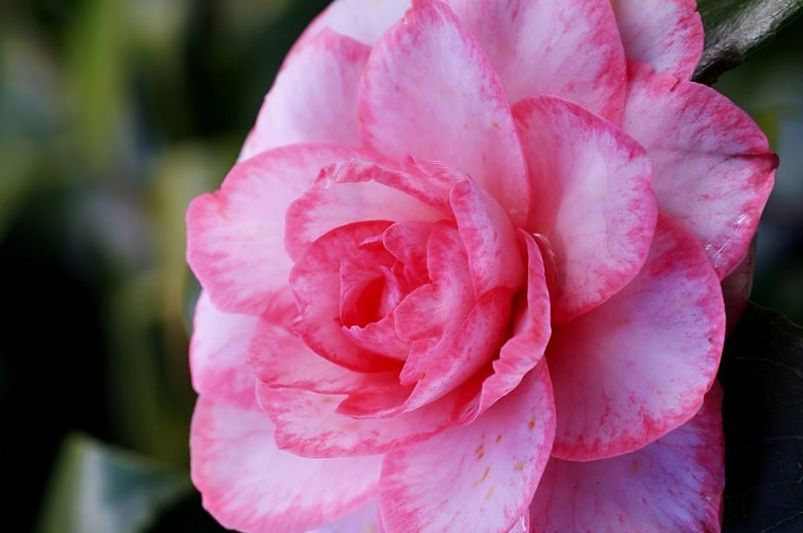
Leslie Ann Camellia
The Camellia' Leslie Ann' is a spectacle of beauty, featuring semi-double blooms that showcase a mesmerizing blend of pinks and whites. This variety excels in USDA Hardiness Zones 7 through 9, demonstrating a robust growth pattern that reaches up to 5 feet in height and spread, making it perfect for ornamental borders or as a focal point in any garden.
Plantation & Growth
This camellia thrives in well-drained, slightly acidic soil rich in organic matter. It prefers a spot that enjoys partial shade, safeguarding its delicate blooms from the full force of the afternoon sun while basking in the gentler morning light. Providing shelter from strong winds will protect its elegant form and flowers. Planting in the fall allows the 'Leslie Ann' to establish its root system in cooler temperatures, setting the stage for vigorous growth.
Plant Care
Regular watering, particularly during dry spells, ensures it remains vibrant. Annual mulching helps retain soil moisture and regulate temperature. An early spring feed with acid-formulated fertilizer encourages healthy growth and bloom production.
Pruning & Propagation
Prune in late winter or early spring, after the blooms have faded but before the emergence of new growth. This not only maintains its shape but also promotes vigorous flowering. Propagation is commonly performed through semi-hardwood cuttings in the late summer.
Common Pests & Disease
It is resilient but susceptible to aphids, scale, and spider mites. Good air circulation and proper watering techniques are preventive. Watch for camellia root rot and treat immediately if symptoms appear. With these care practices, Camellia' Leslie Ann' will be a show-stopping feature of beauty and grace in your garden throughout the cooler months.
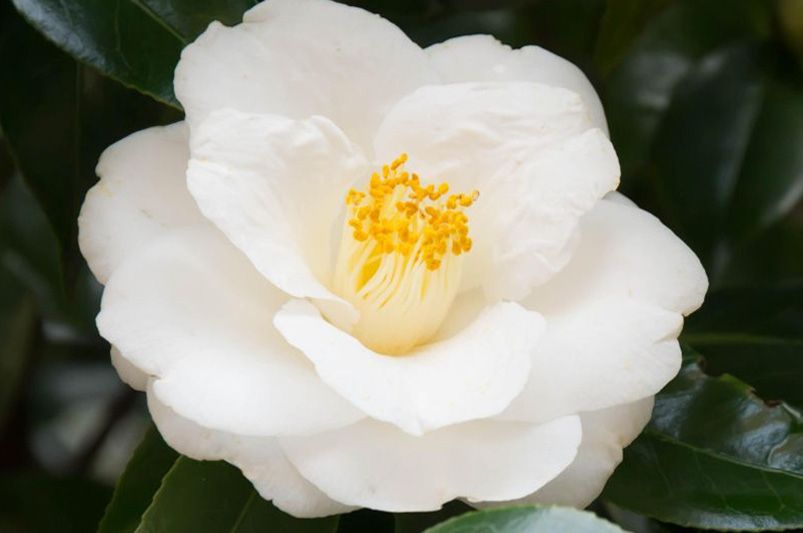
Mine No Yuki Camellia
Camellia' Mine No Yuki,' which translates to "Snow on the Mountain," is an enchanting variety that bursts into a cloud of white, double blooms each fall. This vigorous shrub grows well in USDA Hardiness Zones 7 through 9, reaching a mature height and spread of 6 to 8 feet, making it a splendid choice for garden borders, hedges or as a standalone specimen.
Plantation & Growth
Plant' Mine No Yuki' in a sheltered location to protect its delicate blooms from solid winds. It favors well-draining, acidic soil enriched with organic matter. A partially shaded site is ideal, where it can enjoy morning sunlight with protection from the harsh afternoon rays. Planting in the fall encourages root development in cooler temperatures, setting a solid foundation for spring growth.
Plant Care
Maintaining consistent moisture is essential, particularly during dry spells. A layer of organic mulch will help retain soil moisture, regulate temperature, and suppress weeds. In early spring, fertilize with an acid-forming fertilizer to promote healthy growth and abundant flowering.
Pruning & Propagation
Prune immediately after flowering to shape the plant or manage its size, as 'Mine No Yuki' sets the next season's buds shortly after blooms fade. Propagation can be achieved through semi-hardwood cuttings taken in late summer.
Common Pests & Diseases
While 'Mine No Yuki' is generally robust, it can be susceptible to pests like scale insects, aphids, and spider mites. Regular monitoring and early treatment are crucial. Preventative measures like proper watering, good airflow, and cleanliness can fend off root rot and camellia petal blight. With meticulous care, Camellia' Mine No Yuki' will adorn your garden with snow-like blossoms, bringing serene beauty during the cooler months.
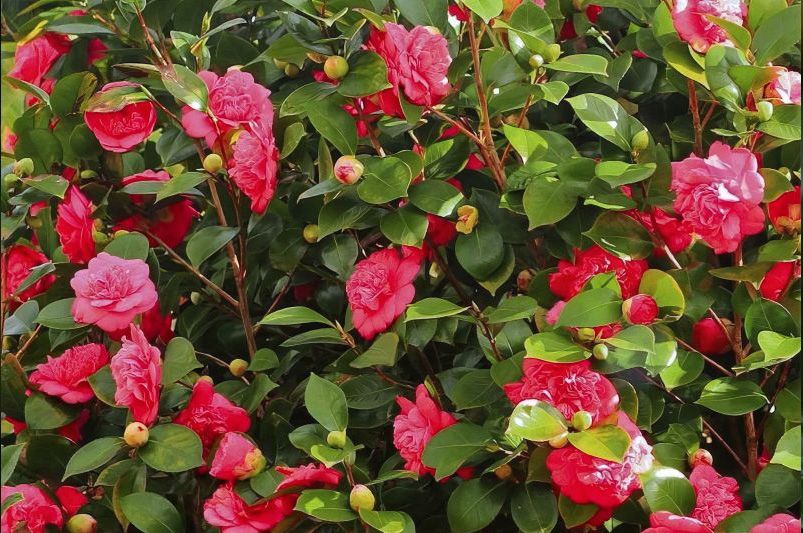
Red Twister Camellia
Camellia' Red Twister' presents a stunning display with its unique, spiraled deep red petals, a thrilling departure from the traditional camellia bloom. Thriving in USDA Hardiness Zones 7 through 9, this variety can reach 6 to 8 feet in height and spread, making it an exquisite addition to any garden as a border, hedge, or focal point.
Plantation & Growth
Choose a location where 'Red Twister' can bask in partial shade, receiving filtered sunlight that encourages vibrant blooms without the risk of scorching. It prefers well-draining, acidic soil rich in organic content. Planting in the cooler months of fall or early spring allows the camellia to establish itself before the stress of extreme temperatures. This period of adjustment is crucial for its thriving growth.
Plant Care
'Red Twister' demands constant moisture but detests waterlogged roots, making efficient drainage necessary. Mulching with organic matter retains moisture and regulates root temperature. Feeding with an acid-based fertilizer in the early spring fosters a flush of growth and blooms.
Pruning & Propagation
Pruning should be done right after the blooming period ends, focusing on shaping the plant and removing any dead or weak branches to stimulate next year's growth. Camellia' Red Twister' can be propagated by semi-hardwood cuttings in late summer, ensuring the continuity of this spectacular variety.
Common Pests & Diseases
This camellia is resilient but can fall victim to pests such as spider mites and scale insects under stress. Maintaining proper air circulation and moisture levels can prevent these issues. Additionally, watch out for camellia root rot and treat it promptly to protect your 'Red Twister' and ensure its longevity as the centerpiece of your garden.
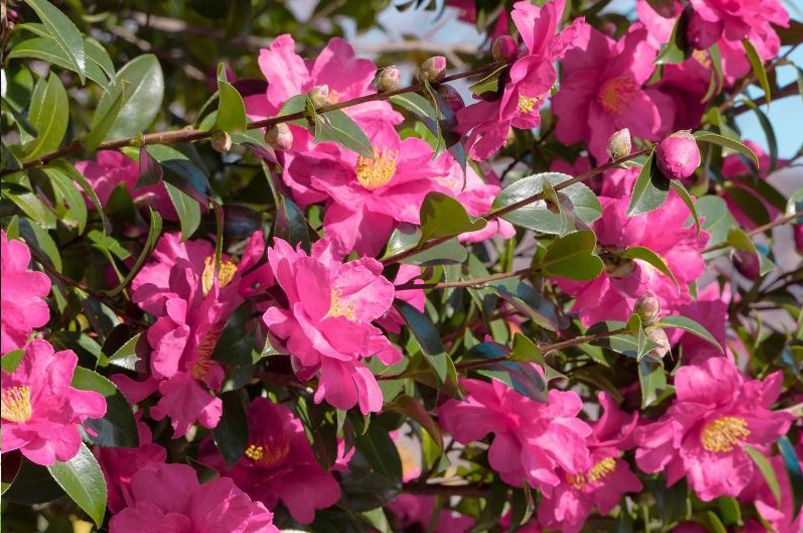
Rose Of Autumn Camellia
Camellia' Rose of Autumn' captivates gardeners with its stunning, rosy-pink flowers that resemble soft, miniature roses. This charming variety thrives in USDA Hardiness Zones 7 to 9. It can grow to 8 to 10 feet tall and wide, making it an impressive addition to residential landscapes as a hedge, screen, or standalone specimen.
Plantation & Growth
For optimal growth, the 'Rose of Autumn' should be planted in partially shaded areas where it can receive filtered sunlight. The plant favors well-draining, acidic soil rich in organic material. Position it sheltered to protect the delicate blooms from solid winds. Planting in late fall or early spring allows the camellia to establish a robust root system before the extremes of summer or winter.
Plant Care
Maintaining regular moisture is crucial, especially during dry spells. However, avoid overwatering, as camellias are prone to root rot in soggy soil. A mulch layer of pine needles or shredded bark will help retain soil moisture while keeping the roots cool. Applying a specialized camellia or acid-loving plant fertilizer in early spring will support vigorous growth and flowering.
Pruning & Propagation
Prune the 'Rose of Autumn' immediately after flowering to shape the bush and remove any diseased or crossing branches, ensuring better light and air circulation. In late summer, semi-hardwood cuttings can effectively propagate the plant.
Common Pests & Diseases
Watch for common pests like aphids, scale, and spider mites. Regular inspections and prompt treatment of infestations are essential. Disease concerns include root rot and camellia leaf gall; both can be managed through sound cultural practices and appropriate plant placement to enhance airflow.
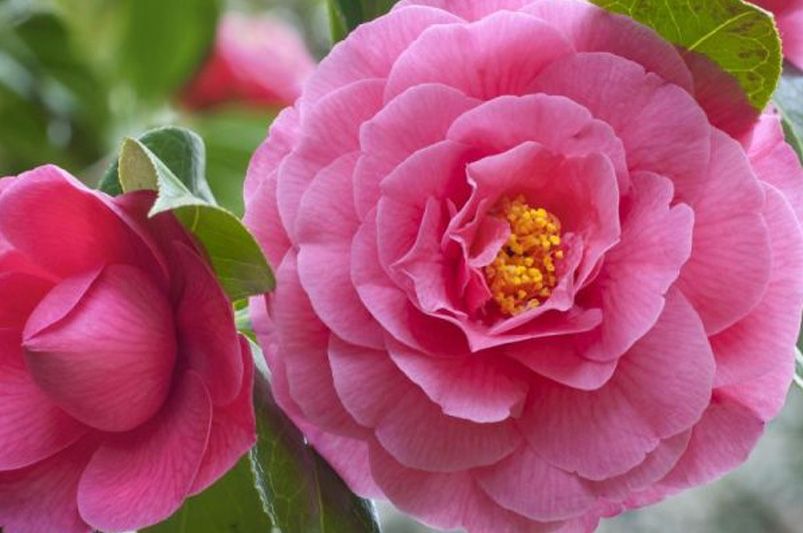
Shi Shi Gashira Camellia
Camellia' Shi Shi Gashira' with pink blooms is a picturesque variety that enchants gardeners with vibrant pink flowers. Suitable for USDA Hardiness Zones 7 to 9, this dwarf camellia offers a compact growth habit and can reach 4 to 5 feet in height and spread. Its lush, glossy foliage and profuse blooms make it an excellent choice for small gardens, borders or as a delightful container plant.
Plantation & Growth
This camellia variety thrives in partial shade to partial sun locations, where it can be sheltered from the intense midday heat. Well-draining, acidic soil is essential for 'Shi Shi Gashira,' while adding organic compost at planting can encourage robust root development. Opting for a protected spot will also shield the delicate blooms from harsh weather conditions.
Plant Care
To ensure optimal growth, maintain evenly moist soil, especially during hot, dry periods. A 2 to 3-inch layer of organic mulch helps retain soil moisture, suppress weeds, and stabilize root temperatures. Fertilize in the early spring with a formula designed for acid-loving plants to promote healthier, more vibrant blooms.
Pruning & Propagation
Pruning should be minimal and conducted immediately after flowering to maintain shape and encourage bushier growth. 'Shi Shi Gashira' can be propagated via semi-hardwood cuttings in late summer, offering an easy method to multiply your cherished plants.
Common Pests & Diseases
While 'Shi Shi Gashira' is relatively resistant to pests and diseases, it's still wise to watch for signs of aphids, scale insects, and spider mites. Regularly check the plant and treat it promptly if infestations occur. Good cultural practices, such as ensuring proper air circulation and avoiding overhead watering, can minimize disease risk.
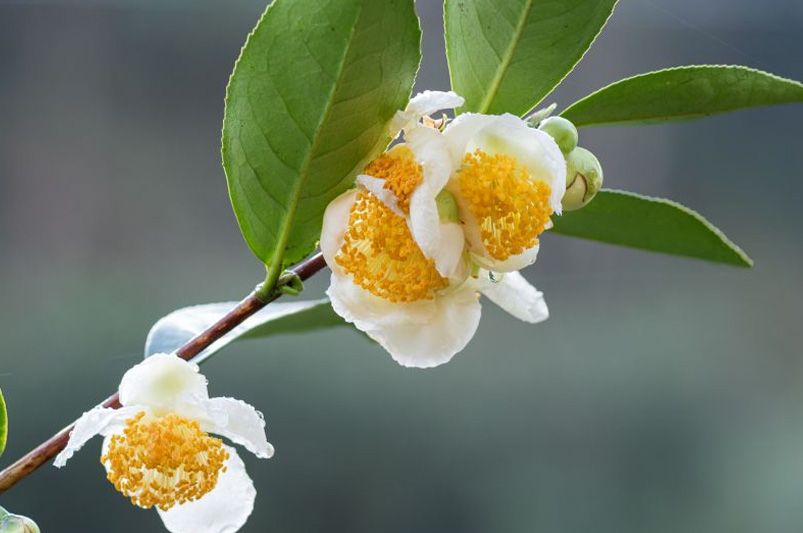
Sinensis Green Tea Camellia
The esteemed tea plant Camellia Sinensis is recognized for its invaluable leaves used in tea production and its graceful, white blooms. Thriving in USDA Hardiness Zones 7 through 9, it grows to a moderate height of 6 to 8 feet, making it suitable as both a garden plant and a source of green tea.
Plantation & Growth
The ideal plantation begins in a location that receives partial shade to full sun, which protects the plant from the harsh afternoon heat in warmer climates. Camellia Sinensis prefers well-draining, slightly acidic soil. Incorporating compost during planting time will encourage a robust, healthy root system. Space plants 4 to 6 feet apart to allow for mature growth.
Plant Care
Regular watering is essential, especially during dry periods, to keep the soil moist but not soggy. A thick layer of mulch will help retain soil moisture and keep the roots cool. Apply a balanced, acid-forming fertilizer in spring to support vibrant growth and tea leaf production.
Pruning & Propagation
Prune in late winter or early spring to shape the plant and encourage bushier growth, which is vital for increasing the yield of tea leaves. In summer, Camellia Sinensis can be propagated through semi-hardwood cuttings, providing a method to expand your tea garden.
Common Pests & Diseases
While relatively low-maintenance, Camellia Sinensis can occasionally suffer from pests like spider mites and scale insects. Aphids are another common bother. Diseases include root rot and leaf spots, both manageable through proper cultural practices like ensuring good drainage and air circulation around the plants. Regular inspection and prompt treatment can keep your camellias healthy, preserving beauty and productivity.
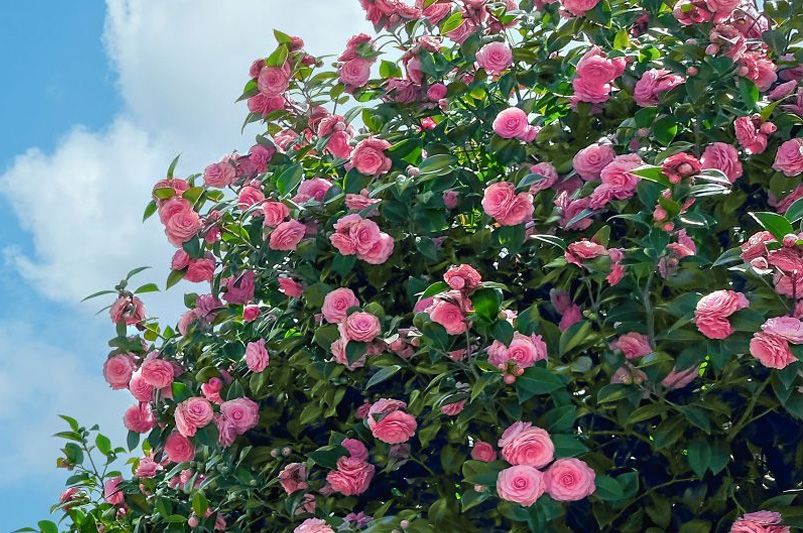
Susy Dirr Camellia
Camellia' Susy Dirr' is a captivating variety that stands out for its striking, peony-form blooms in shades of vibrant pink. Suited for USDA Hardiness Zones 7 to 10, this camellia makes a splendid addition to any garden. It reaches an average height and spread of 6 to 8 feet and is ideal for borders, hedges, or as a stunning solitary specimen.
Plantation & Growth
For optimal growth, 'Susy Dirr' should be planted in a site that receives partial shade, with shelter from the intense afternoon sun. It prefers well-draining, acidic soil rich in organic matter. Planting in the early spring or fall allows for more accessible establishment in moderate temperatures. Space plants accordingly to accommodate their mature size.
Plant Care
'Susy Dirr' camellias require consistent moisture, especially in the warmer months. However, waterlogging the soil should be avoided to prevent root issues. A layer of organic mulch will help retain soil moisture, suppress weeds, and keep the roots cool. Fertilize in early spring with an acid-forming fertilizer to encourage lush foliage and abundant blooming.
Pruning & Propagation
Prune' Susy Dirr' immediately after flowering to maintain its shape and remove damaged or diseased branches. This timing ensures the plant does not lose the next season's buds. Propagation through semi-hardwood cuttings in late summer is generally successful, allowing gardeners to share this beautiful variety.
Common Pests & Diseases
Camellia' Susy Dirr' is relatively resilient but susceptible to common camellia pests like aphids, scale insects, and spider mites. Root rot and camellia leaf gall are potential diseases, primarily preventable with proper planting and care techniques, such as ensuring good drainage and avoiding overhead watering. Regularly inspecting and maintaining your camellias will help keep them healthy and vibrant for years.
Camellia Companions
Camellias are undoubtedly the stars of the garden, but their beauty can be further enhanced by carefully selecting complementary plants that create a harmonious and visually appealing garden. When choosing companion plants for camellias, consider their growth habits, bloom times, and color palettes to create a cohesive and visually stunning display.
Evergreen Shrubs: Evergreen shrubs like azaleas, rhododendrons, and Japanese skimmias make excellent companions for camellias. Their glossy foliage and vibrant blooms provide a lush backdrop for the camellias' exquisite flowers. Azaleas, in particular, share a similar bloom time with many camellia varieties, creating a stunning tapestry of colors in the garden.
Shade-Loving Perennials: Camellias thrive in partial shade, making them ideal partners for shade-loving perennials. Consider planting hostas, ferns, or hellebores around the base of your camellia shrubs. These low-growing plants will create a lush, green carpet that complements the camellias' foliage and flowers.
Japanese Maples: Japanese maples' delicate, lacy foliage and graceful form contrast with camellias' dense, glossy leaves and formal shape. Plant a Japanese maple near your camellia for a stunning focal point in the garden.
Ornamental Grasses: Ornamental grasses add texture and movement to the garden, making them excellent companions for camellias. Consider planting varieties like Japanese forest grass or fountain grass around the base of your camellia shrubs. Their graceful, swaying foliage will contrast beautifully with the camellias' dense foliage and formal shape.
Spring-Blooming Bulbs: For an added burst of color in the early spring, plant spring-blooming bulbs around the base of your camellia shrubs. Daffodils, crocuses, and hyacinths will provide a vibrant display of color before the camellias begin to bloom, creating a seamless transition from one season to the next.
Remember, when selecting companion plants for your camellias, consider their growth habits, bloom times, and color palettes to create a cohesive and visually stunning display in your garden.
Your Guide to Timeless Elegance: The Last Word on Selecting the Perfect Camellia
Camellias are truly remarkable plants that offer a wealth of beauty and diversity throughout the seasons. From the early bloomers that herald the arrival of spring to the winter wonders that defy the cold, these evergreen shrubs provide a stunning array of colors, forms, and fragrances.
Whether you're seeking a compact plant for a container or a stately specimen for your landscape, there is a camellia to suit every garden. With their glossy foliage and exquisite blooms, camellias are a delight to the eyes and a source of joy and tranquility for the soul.
Exploring the world of camellias is an enriching journey that gardeners of all levels can enjoy. From attending local camellia shows and festivals to joining societies dedicated to these plants, there are numerous opportunities to learn, share, and connect with fellow enthusiasts. So, embrace the beauty of camellias and let them grace your garden with their timeless elegance. Visit ShrubHub, which offers a dazzling array of camellias, from delicate blush to vibrant red! Explore our selection and find the perfect fit for your garden.


